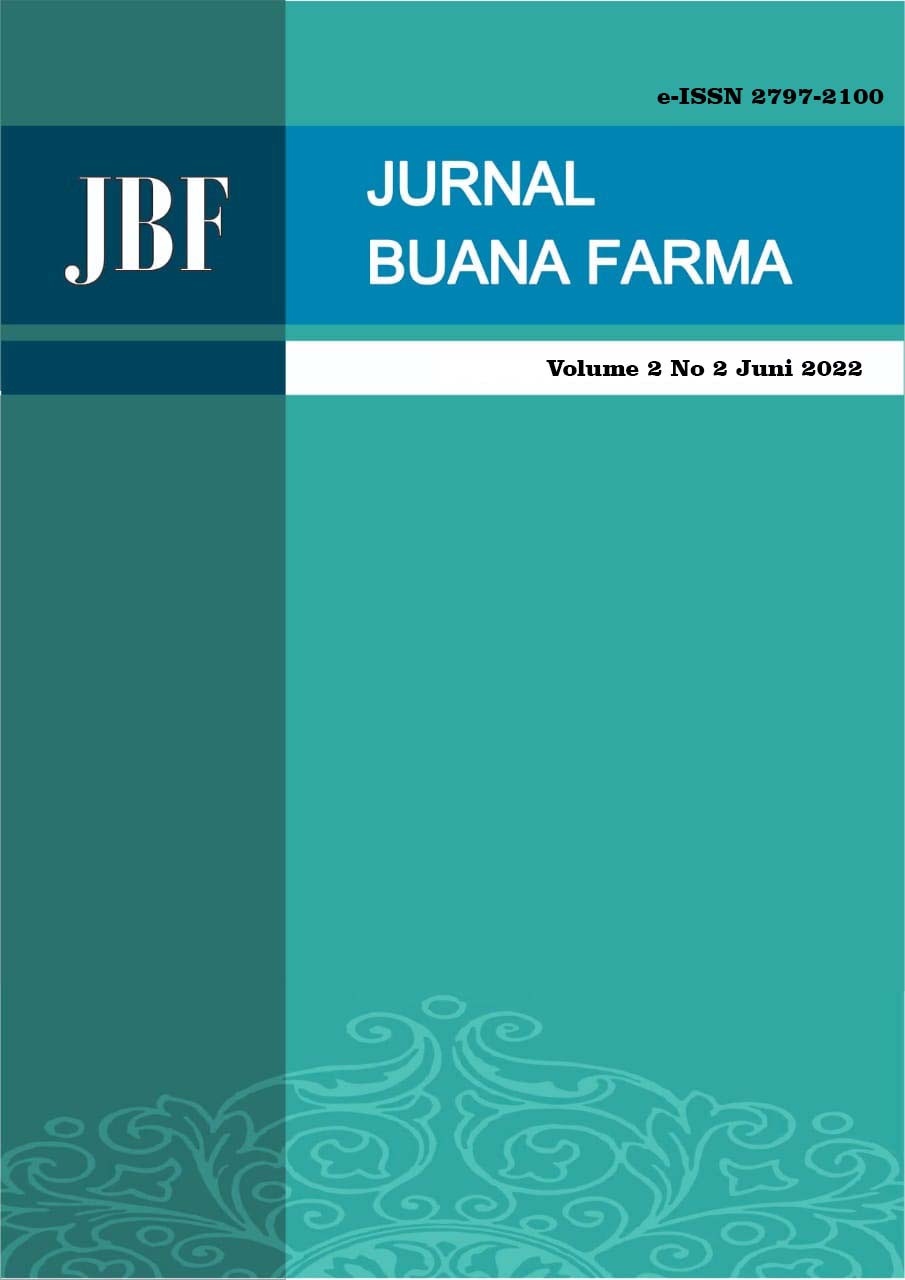UJI AKTIVITAS ANTIJAMUR EKSTRAK DAUN (Ipomoea carnea Jacq) TERHADAP Candida albicans
Abstract
Infectious diseases can be transmitted from one person to another or from animals to humans of the causes of infection diseases is fungi. Fungi are microorganisms in the form of cells or branched threads. These microorganisms have a rigid cell wall and composed of polysaccharides or chitin, have nuclei and spores, are not chlorophyllous and do not multiply sexually and asexually. Based on this, research was carried using of the welling method on antifungal bioactivity as well as a thin layer chromatography test of spotting to determine the content of secondary metabolites contained in the leaves of kale fence. This study aims to determine the bioactivity of secondary metabolites in n-hexane extract, ethyl acetate, and methanol of kangkong pagar leaves (Ipomoea carnea Jacq) against Candida albicans fungi. This study made four different concentrations namely 60%, 80%, 100%, 120%, for positive control using ketoconazole and negative control using CMC 1%. Data analysis is using the One Way ANOVA test. From this study, the results were that kale fence leaf extract contains secondary metabolites, namely flavonoids, tannins, steroids. Then the results of the antifungal activity test of fencing kale leaves have activities that can inhibit fungi at a concentration of 120% with an inhibitory zone diameter of 11,254 mm so that they can be classified as strong antifungal bioactivity, in the results of the One Way ANOVA analysis of the three samples (N Hexana, Methanol and ethyl Acetate), it is known that the Sig value is 0.000 < 0.05 so it can be said that the rata_rata is "Significantly Different".
References
Advistasari, Y. D. Skrining Fitokimia, Karakterisasi, dan Penentuan Kadar Flavonoid Total Ekstrak dan Fraksi-Fraksi Buah Parijoto (Medinilla speciosa B.). Prosiding Seminar Nasional Unimus; 2018: Volume. e-ISSN: 2654-3257 p-ISSN, 2018; 1: h 2654-3168.
Bhalerao, S. A. (2016). Ipomoea carnea Jacq.: Ethnobotany, Phytochemistry and Pharmacological Potential. International Journal of Current Research in Biosciences and Plant Biology ISSN. 2016; Volume 3, Number 8: h 2349-8080.
Christoper, W., Natalia, D., Rahmayanti, S. (2017). Uji Aktivitas Antijamur Ekstrak Etanol Umbi Bawang Dayak (Eleutherine americana (Aubl.) Merr. Ex K. Heyne.) terhadap Trichophyton mentagrophytes secara in Vitro. Jurnal Kesehatan Andalas. 2017; Volume 6, Nomer 3, : h 685-689.
Dahlisa, S. (2017). Aktivitas Antifungi Ekstrak Metanol Kulit Batang Jambu Mete terhadap Candida albicans. Journal Cis-Trans (JC-T). e-ISSN 2549-6573, 2017; Volume 1, Nomor 2: h 2549-6573.
Dewi S, Dkk. (2019). Efek Ekstrak Etanol Daun Kesum (Polygonum minus Huds.) Sebagai Antifungi Terhadap Tricopyhython rubrum. Journal Kesehatan Andalas.2019 ;8(2).
Ganjari, L. E. Keanekaragaman dan Aktivitas Kumbang Kura-Kura (Tortoise) Pada Tanaman Kangkung Pagar (Ipomea Carnea) di Madiun. Widya Warta No. 02 Tahun XL/Juli 2016; 270: h 0854-1981.
Kojong , N. Uji Aktivitas Antijamur Ekstrak Etanol Batang Rambutan (Nephelium lappaceum L.) Terhadap Jamur Candida Albicans Secara In Vitro. Program Studi Farmasi, FMIPA UNSRAT Manado, 2016; 95115: h 8-10.
Departemen Kesehatan Republik Indonesia. Materia Medika Indonesia Jilid III. Jakarta: Direktorat Pengawasan Obat dan Makanan. 1979; p.29: h 180
Maryam, F. Pengukuran Parameter Spesifik dan Non Spesifik Ekstrak Etanol Daun Matoa (Pometia pinnata J.R & G. Forst) Jurnal Mandala Pharmacon Indonesia, juni 2020 ISSN 2442-6032, 2020: Vol 6.No.1
Mukhriani. Ekstraksi, Pemisahan Senyawa, Dan Identifikasi Senyawa. Program Studi Farmasi Fakultas Ilmu Kesehatan UIN Alauddin Makasar.Jurnal Kesehatan, 2014; Volume 8 Nomer.2
Rumayar, R. Formulasi dan Uji Aktivitas Antijamur Sediaan Krim Ekstrak Metanol Ketepeng Cina (Cassia alata L.) Terhadap Jamur Candida albicans. Pharmacon– Program Studi Farmasi, FMIPA, Universitas Sam ratulangi, 2020; Volume 9, Nomor 3: h 366-368.













